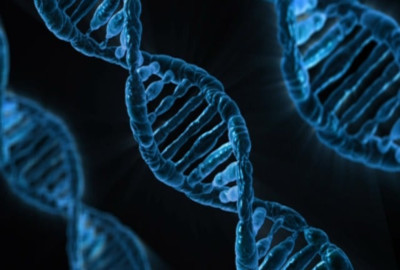DNA, also known as deoxyribonucleic acid, carries the heritage material. Almost all living organisms have DNA. Almost all the cells in our body have an exact replica of DNA. Most of the DNA is found in the nucleus, and then it is called nuclear DNA, but there is also a little bit of DNA in mitochondria. Then it is called mitochondrial DNA. There is also RNA, which is called ribonucleic acid. Together with DNA, they are known as nucleic acids.
The information in DNA is stored in a code, which is made up of four chemical bases. They are: adenine (A), guanine (G), cytosine (C), and thymine (T). Human DNA is composed of 3 billion bases, and 99% of the sequence is exactly the same in all people. The way the sequence is put together determines how an organism is built and how it works. DNA fallows a code, so certain bases pair up with each other: A and T are together, and C and G are together. Each base is also attached to a sugar or phosphate molecule. The sugar is called deoxyribose. Altogether, the base, sugar, and phosphate form a nucleotide. The nucleotides are attached to each other, forming two long strands. Those strands form a spiral, called a double helix. The double-helix structure is often described as a spiralled ladder.
An important feature of DNA is that it can make copies of itself. Both of the DNA strands are used as a pattern to make a new DNA strand. It is used when the cells are divided because every cell has to have the exact same DNA. In eukaryotic cells, the DNA is backed together into chromosomes.
For a larger group of people, the discoverers of DNA were American biologist James Watson and English physicist Francis Crick in 1953, but this is not completely true. DNA was first described by Swiss chemist Friedrich Miescher in the 1860s. Then, many years later, other scientists made discoveries that gave more information about DNA. For example, Phoebus Levene and Erwin Chargaff found out the primary chemical compounds of DNA and also the way they were paired up. Watson and Crick used their discoveries to make their conclusions.
The Swiss physiological chemist made his discovery with human white blood cells. He found that the inside of nuclei is nuclein. The term ‘nuclein’ is now called nucleic acid. His aim was to identify different types of proteins inside white blood cells, but when he did the ‘washing’, then he noticed that the substance had a different structure compared to a typical protein. It had more phosphorus in it. More than 50 years after his discovery, DNA was ‘accepted’ by the scientific community. Unfortunately, Miescher didn’t get any credit for his discovery.
The next bigger discoveries were made by Russian scientist Phoebus Levene. He was a very productive scientist. He discovered a lot of different chemical and biological molecules. He discovered that DNA is made of three compounds: phosphate, sugar, and base. He also discovered that RNA is made out of sugar called ribose and DNA is made of sugar called deoxyribose. But still, the scientist didn’t know how DNA is arranged in space.
Levene’s work was continued by Erwin Chargaff, an Austrian biochemist. Chargaff got inspired by Oswald Avery’s, who discovered that DNA carries on the heritage information in the form of genes. The first thing Chargaff wanted to find out was whether there was a difference in DNA among the species. During this research, he made two big discoveries. One of them was that nucleotide compounds were in different order among the species. The other discovery was that all the cells have a similar amount of adenine and thymine, and the amount of guanine and cytosine is also similar. It is now named ‘Chargaff’s rule’.
In 1952, a British scientist named Rosalind Franklin took photographs of crystallized DNA fibres. Her discoveries were major at the time, and the other thing about them was that they were done by a woman. Thanks to her, the scientist now knows the shape of DNA. She also discovered that the phosphates of DNA were outside of the helical structure. The picture she took is now known as ‘Photo 51’. And in the picture, you can see a hydrated form of DNA.
The discoveries that A=T and C=G are together or paired in DNA, as well as Rosalyn Franklin’s x-ray crystallography work, helped Watson and Crick’s form the three-dimensional and double-helix DNA model. Watson and Crick’s discoveries were also made easier because of the new ways of building models. They knew how far and at what angle the molecules were combined. After the discovery in 1953, scientists have only made some small changes to the DNA structure, as suggested by Watson and Crick. In 1962, they were awarded the Nobel Prize.
So, in conclusion, the discoveries made by different scientists about DNA structure are as follows: The DNA is shaped in a double-strand helix, and the strands are connected by hydrogen bonds. DNA is mostly right-handed. The DNA double helix is anti-parallel. This means that the 5′ end is combined with the 3′ end.
Different discoveries about DNA are continuing. In 1972, DNA from two different organisms was combined, which marked the start of GMO. In 1996, the first clone was born: Dolly the sheep. In 2003, a mega project that cost $3 billion and lasted more than 13 years was finished. It was called the ‘Human Genome Project’, and with this, the entire genome is published. Nowadays, everyone can let their genome be sequenced, and it costs only around 100 euros. Now we are moving towards personalized medicine.
Sources:
https://medlineplus.gov/genetics/understanding/basics/dna/
https://en.wikipedia.org/wiki/DNA
https://www.nature.com/scitable/topicpage/discovery-of-dna-structure-and-function-watson-397/
https://www.dna-worldwide.com/resource/160/history-dna-timeline
https://www.sciencefocus.com/the-human-body/dna-a-timeline-of-discoveries

